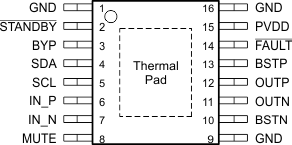SLOS814D March 2014 – September 2016 TAS5421-Q1
PRODUCTION DATA.
- 1 Features
- 2 Applications
- 3 Description
- 4 Revision History
- 5 Pin Configuration and Functions
- 6 Specifications
- 7 Detailed Description
- 8 Application and Implementation
- 9 Power Supply Recommendations
- 10Layout
- 11Device and Documentation Support
- 12Mechanical, Packaging, and Orderable Information
Package Options
Mechanical Data (Package|Pins)
- PWP|16
Thermal pad, mechanical data (Package|Pins)
- PWP|16
Orderable Information
5 Pin Configuration and Functions
Pin Functions
| PIN | TYPE(1) | DESCRIPTION | |
|---|---|---|---|
| NAME | NO. | ||
| BSTN | 10 | AI | Bootstrap for negative-output high-side FET |
| BSTP | 13 | AI | Bootstrap for positive-output high-side FET |
| BYP | 3 | PBY | Voltage-regulator bypass-capacitor pin |
| FAULT | 14 | DO | Active-low open-drain output used to report faults |
| GND | 1 | GND | Ground |
| 9 | |||
| 16 | |||
| IN_N | 7 | AI | Inverting analog input |
| IN_P | 6 | AI | Non-inverting analog input |
| MUTE | 8 | DI | Mute input, active-high (no internal pullup or pulldown) |
| OUTN | 11 | PO | Output (–) |
| OUTP | 12 | PO | Output (+) |
| PVDD | 15 | PWR | Power supply |
| SCL | 5 | DI | I2C clock |
| SDA | 4 | DI/DO | I2C data |
| STANDBY | 2 | DI | Active-low STANDBY pin (no internal pullup or pulldown) |
| Thermal pad | — | — | Must be soldered to ground |
(1) DI = digital input, DO = digital output, AI = analog input, PWR = power supply, PBY = power bypass, PO = power output, GND = ground
